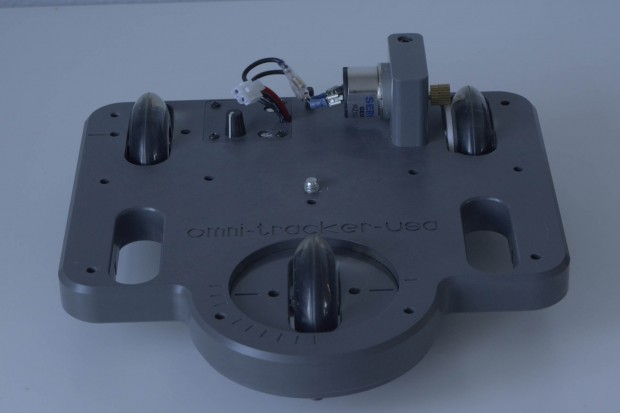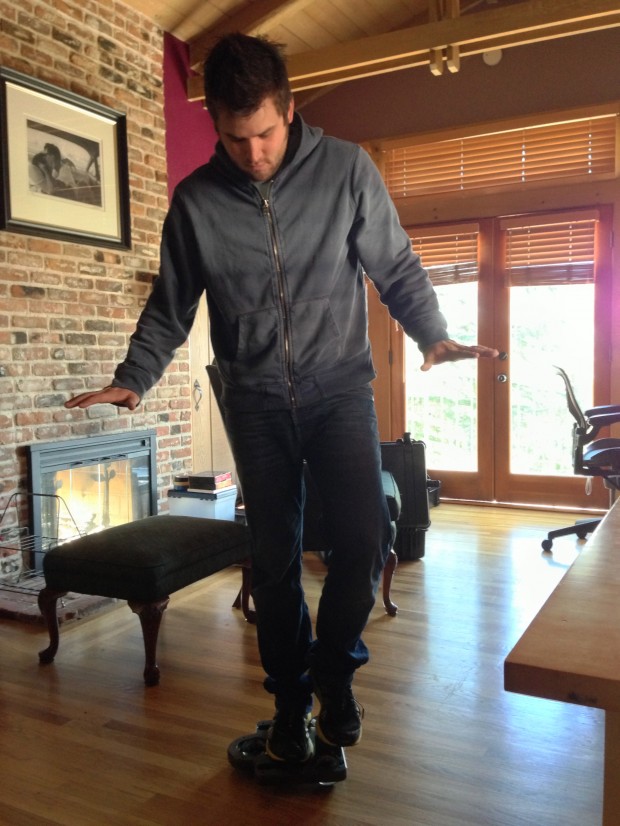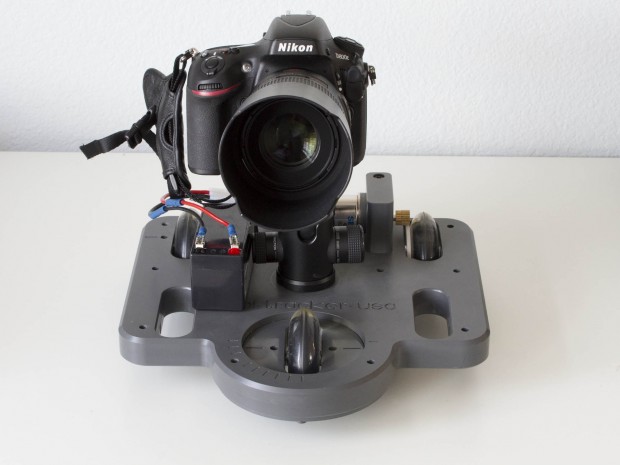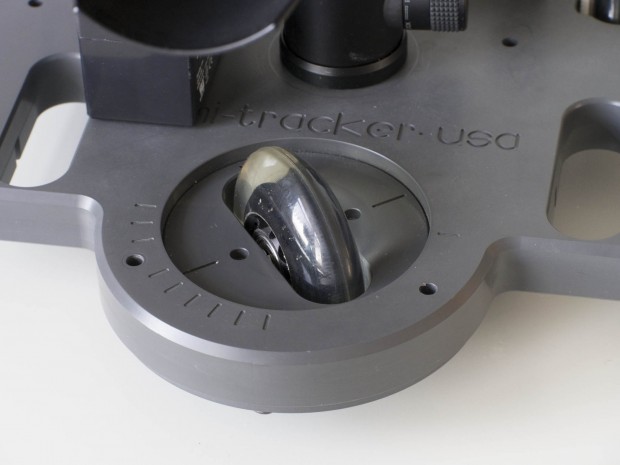I stumbled on this gem via Kickstarter a week or two ago and reached out to my camera tech pal Sohail to get his take. In short, we cranked out this review in short order to give you a first look AND… I’ve got another prototype en route to my studio now to put it thru the paces of an actual commercial job… Will report back again after all is said and done, but in the meantime, Sohail goes deep with this little monster and validates that this motion-control timelapse dolly is a worthy endeavor… Take it away, Sohail… – chase
Often, the simplest of ideas, executed without bloat, result in the most elegant and useful of solutions. That is what the L’il Mule personifies. In fact, when it was handed to me, my first reaction was, “That’s it?”
That was, in fact, it. The L’il Mule is a trackless dolly that is the brain child of Warren Herndon, the man behind the popular Omni-Tracker line of video dollies. Warren appears to have taken the feedback he received from the Omni-Tracker to heart and has used it to build a dolly that, if you’re interested in video or timelapse, you should take a good look at. The Kickstarter project that he used to launch the L’il Mule is still ongoing, and has been funded at over 200%.
Design, Build, and Construction
Let’s get one thing out of the way. If you’re expecting a polished and finished product with pretty logos and all the nuts, screws, wiring, and attachments all tucked away, you’re going to be disappointed. The L’il Mule is about as bare-bones as things come. This is going to turn off a few folks who expect to receive a retail-packaged item, but don’t let the spartan look and feel of the dolly fool you; this is an extremely capable little gadget.
Guerrilla filmmakers, meet your new favorite dolly.
What you see above is pretty-much what you get. If you’re going to use it for manual video moves, this is all you need. If you want to take advantage of the motorized functionality, you’ll need to get a battery. I know – a seemingly simple hurdle, but it gets complicated given the international nature of Warren’s clientele, different power and shipping regulations, etc. As such he doesn’t – at this time – ship batteries with his dolly. That’s up to you to get, though he does recommend a standard 12v battery, like the one you can buy from Fry’s. You’ll also need a charger for the battery.
I spoke to Warren and he is currently working on sourcing a battery and charger that is both competitively priced and is easy to travel with, as it is not as regulated as the battery linked above. Stay tuned for more information about that.
The battery was the first thing that made me frown. I’m used to neatly tucked away power supplies and well-laid out wiring. There’s none of that here, but it gets better from this point on…
The L’il Mule is a block of solid plastic, with no hollow spaces where you can hide a power source or wiring. How solid is it? Well, here’s a picture of my buddy Thom standing on the darn thing.
So, yeah. It’s pretty solid. Which means that the battery and any other accessories you’d like to add must find a spot somewhere on the surface of the dolly. You plug the battery into the motor, then figure out where to put the battery down.
Turns out, that’s pretty darn handy. I ended up positioning my camera at multiple different angles and that, and realized quite quickly that a fixed position for the battery anywhere on the surface of the dolly would be inconvenient at best. Being able to move it around wherever I needed to meant it stayed out of the way. I slapped a piece of velcro on the bottom of the battery and put a few strips down on the L’il Mule in places where I’d be likely to put it, and that worked fine for me.
At the center of the dolly is a standard 3/8 16 bolt that most tripod heads should be able to screw onto. I recommend using a ball head; a video head isn’t necessary unless you plan on tilting and sliding at the same time.
There are additional holes you can use with standard bolts (not included) to attach things like monitors or lights, without much concern for how much weight you’re putting on the unit. In fact, the more weight you have on it, the better.
Taking some cues from its predecessor, the L’il Mule sticks to the use of large elastomer wheels similar to the ones on the Omni-Tracker, but bumps the number from three to four. This makes it a lot easier to move the L’il mule in a straight line; the four wheels fit into groves at the four corners of the dolly.
On one end of the dolly, however, is a fifth wheel slot. You can remove two wheels from one end and put one of them into the fifth slot, located between two of the corner slots, and the L’il Mule transforms from a straight-line dolly to one capable of moving in an arc with a variable radius.
One of the two fixed wheels in the back also has a gear attached to it. A bracket adjacent to it allows you to fit a motor with a geared tip, turning the L’il Mule from a standard manual dolly to a fully motorized version. The gears are attached and detached to and from different motors by using a simple hex wrench, and the bracket holding the motor is loosened and tightened with a larger hex wrench.
In the Field
In practice, the arcing ability proved to be one of the unit’s marquee features. If you’ve done slider moves with a straight-line dolly before, you know that getting your shot to reflect that move takes some planning. With the L’il Mule, even a slight arc — about 10 or 20 degrees — can result in some pretty dramatic motion and the resulting footage looks like a cross between a pan and a slide.
Even more useful is putting the dolly down on a table and rotating it around an object, as you can see in the (really rough and noisy) footage below.
Another feature worthy of being called out is its size. As I said above, guerrilla filmmakers, meet your new favorite dolly. This thing can be used in places where setting up a straight-line slider without a permit would be like waving a flag saying, “I’m filming without a permit, come stop me!” Drop this thing on the ground, on a park bench or table, on top of a wall, whatever.
I used it to set up a quick arcing video on park bench with a cobbled surface at Treasure Island. The clip is sped up to 300% to bring out any bumps or jerks, and I can see one where I accidentally jostled the table. At normal speed, it’s imperceptible. It’s not perfect, but not bad for the surface I was using it on.
The included 6rpm motor proved to be pretty useful for both video and timelapse. There are two others that are also available, a 0.5rpm motor that timelapse shooters will love, and a 20rpm motor, which should be even more useful for video shooters. In my use, I never took the 6rpm motor off – it proved to be pretty useful for all my shooting. There’s a knob that controls the speed of the attached motor, so you can slow that 6rpm down to an agonizing crawl if you want to.
The Intended Audience
Warren Herndon designed the L’il Mule with shooters like Thomas McCallum and Vincent Guglielmina in mind. Thom and Vin are the guys behind Seventh Movement, a company whose portfolio includes commercial jobs for clients like ESPN, for whom they shot, among other things, the USS Carl Vinson ahead of the Carrier Classic basketball game in 2011. They also have some incredibly heartfelt and outstanding personal work like The Golden Gate Way, a montage of timelapse and video that is just jaw-droppingly fantastic (and that ESPN ended up using parts of as well).
“I asked Warren to motorize the Omni-Tracker,” Thom told me when I talked to him about the practical aspects of shooting with the L’il Mule. “And that’s pretty-much what he gave me.”
I cajoled Thom and Vin into cutting together a custom clip of the footage they shot with the L’il Mule, and they were kind enough to do so. Some of it is already on the Kickstarter website, but there’s some new shots in this edit, which they did specifically for this article.
Lil-Mule Sample Footage from The Seventh Movement on Vimeo.
“The thing is,” Thom said as he nonchalantly stepped onto the L’il Mule to show me how it could handle a lot of weight, “I needed something small and lightweight, something that I could just drop on the ground, start, and go. That’s what this thing does. That’s what’s boss about it.”
What impressed me, however, is that this tool, which was built with working professionals in mind, also proved to be an enabler for someone whose primary medium isn’t the moving image. I didn’t need the full setup of rails, multiple tripods, or motion control systems that I normally need to haul on location when I do shoot motion. No, instead I stuck a ball head on this thing, mounted my D800E, and off I went.
It was a liberating feeling, to be able to shoot with a moving camera, yet leave all the baggage normally associated with it behind.
So who is the intended audience? I’d say that this thing covers a pretty wide gamut. The L’il Mule doesn’t provide the finished product every kind of motion shooter is going to be able to use; rather, it provides a platform for pro shooters looking to cover specific shots, or serves as an enabling device for photographers new to motion.
Conclusion
The L’il Mule isn’t perfect. In my tests, the lack of markings for the motor controller — it’s just a knob you use to control the speed and direction of the motor — is a bit frustrating when you’re trying to replicate results. An on/off switch would have also been nice. Also, one of the L’il Mule’s greatest strengths — it’s ability to work without rails — is also a weakness at times. If the surface isn’t pretty even, there can be some jerky movements. This isn’t a big deal in timelapse, as there’s plenty of latitude (size-wise) to work with, but may be an issue with video.
Despite its flaws, however, the L’il Mule is proving to be the most fun I’ve had shooting motion in a long time. Pros will find much to like here; this is a platform on which you can mount a RED EPIC (the guys at Seventh Movement have) and a bunch of associated gear. You can pull of a 30-foot-long slide on smooth tarmac for a fantastic timelapse, or spin it around an object for a smooth 360º view. Beginners can keep it simple, tossing an HDDSLR or some other video camera on for simple slides or arcing shots to get them started with motion work.
Either way, there’s a lot you can do here, and the L’il Mule’s open construction, solid design, and attractive price point ensure that this is one bit of hardware that’s worth your consideration. And we’ll learn more what Chase thinks after his upcoming commercial gig where he’ll be putting it to use. Standby for more. In the meantime, the kickstarter is still open here. The video is pretty cool…






















Very pricey, looks interesting though although I dont think its something I will be using